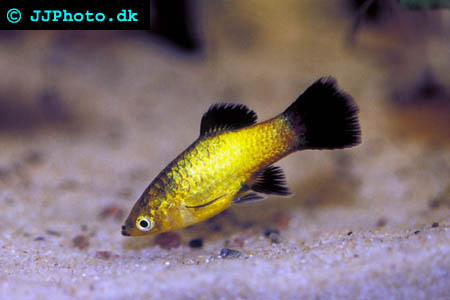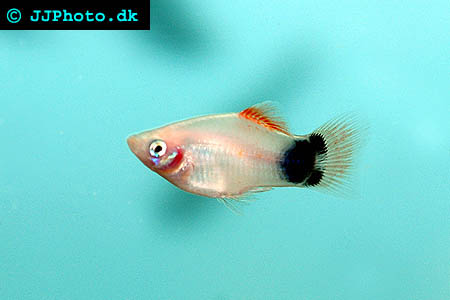Platy Fish
The Livebearer group includes four larger families: Four-eyed Fish (Anablepidae), Halfbeaks (Hemirhamphidae), Mexican Topminnows (Goodeidae), and Live-bearing Toothcarps (Poecilliidae). The Platy is a livebearing Toothcarps and belongs to the Poecilliidae family. It is the larges of the four families and contains nearly 200 species, including several other well known aquarium species, such as Molly, Guppy and Swordtail. All species in the Poecilliidae family are equipped with teeth in both their lower and upper jaw. Theses fishes originate from America, but wild Poecilliidae fish are today found in tropical and subtropical waters in many parts of the world. Most wild Poecilliidae fish found outside America originates from aquarium fish that have been released into the wild by aquarists. In several parts of Asia Poecilliidae fish has however been deliberately introduced in an effort to combat malaria by reducing the amount of mosquitoes.
The Platy is a popular beginner fish, since it is relatively sturdy, easy to care for and also easy to spawn in captivity. It will not grow larger than 2.5 inches and a single Platy can be kept in a 5 gallon aquarium. You can choose from many different Platy variants, including the common red Wagtail Platy. Other popular variants are Sunset Platy, Variatus Platy and Tuxedo Platy. Your Platy will do best if kept in water that is slightly alkaline. It will probably survive on a diet consisting of nothing but flake food, but it will do much better if you supplement the flake food with live or frozen foods. A varied diet ensures that your Platy receives all necessary nutrients to stay strong and healthy. The colours of the Platy can also turn dull from an insufficient diet.
If you want to breed Platy one of the best ways is to buy 2-3 female Platy that are really fat. A fat female Platy are most likely pregnant and you can expect offspring within a month. You can see which Platy are female and which Platy are male by looking at their gonopodium. A gonopodium is the anal fin, or more precisely the anterior portion of the anal fin, that has turned into a copulatory organ. Both male and female fish can display a large gonopodium, but a male Platy will display a gonopodium that is elongated and much larger than that of a female gonopodium. Sperm is transferred from the male Platy to the female Platy via his gonopodium. Your female Platy will become more and more swollen as the birthday comes closer, and it is not unusual for female Platies to look almost like small, square cubes. Feed her a lot of live food in addition to flake food, since live food makes the fry bigger and healthier, while high quality flake food is an excellent base. It is very important that you keep the aquarium clean and remove as much solvable waste as possible. Water changes of approximately 25% should be performed once a week, preferably even more frequent.

One type of platy. Copyright www.jjphoto.dk
If you want to ensure a high survival rate for the Platy fry you should set up a separate fry raising aquarium. Some breeders chose to move the female Platy to the fry aquarium and let her give birth there. Others place a breeding net inside the large aquarium and put the female inside the net, where she and her offspring will be separated from the other fish. The female is not dangerous for her fry during the first 12 hours after the birth, since hormones will prevent her from feeling hungry. A Platy that is moved to a new aquarium or caught inside a net will always find the experience stressful. Stress can cause the female Platy to give birth prematurely, and you should therefore not move her until she looks like she is ready to burst. If you do not want her to experience stress, you can always let her give birth in the large aquarium without being netted. If you provide the fry with a lot of hiding places, they will try to stay away from hungry adults just like they would in the wild. Large gravel, large marbles and densely planted areas with bushy plants are good hiding places for fry. A lot of fry will probably be eaten, but at least a few fry from each batch will usually make it.

Another type of platy fish. Copyright www.jjphoto.dk
Didn't find the info you were looking for? Register for free and ask your question in our Aquarium forum !
Our knowledgeable staff usually responds to any question within 24 hours
Related Articles
Alfaro huberi - How to keep Alfaro huberiArtificial Insemination in Livebearers - Information about how to artificial inseminate livebearers.
Breeding the Guppy - Poecilia reticulata - There is more to breeding guppies than is commonly thought. Selective breeding. Line breeding. Culling.
Breeding Guppy - A beginners' guide to the selective breeding of guppies
Guppy Fish - Information about Guppy Livebearers
Molly Fish - Information about Molly Livebearers
Swordtail Fish - Information about Swordtail Livebearers
Breeding Black Swordtails - How to use basic genetics in order to selectively breed the ultimate swordtail.
